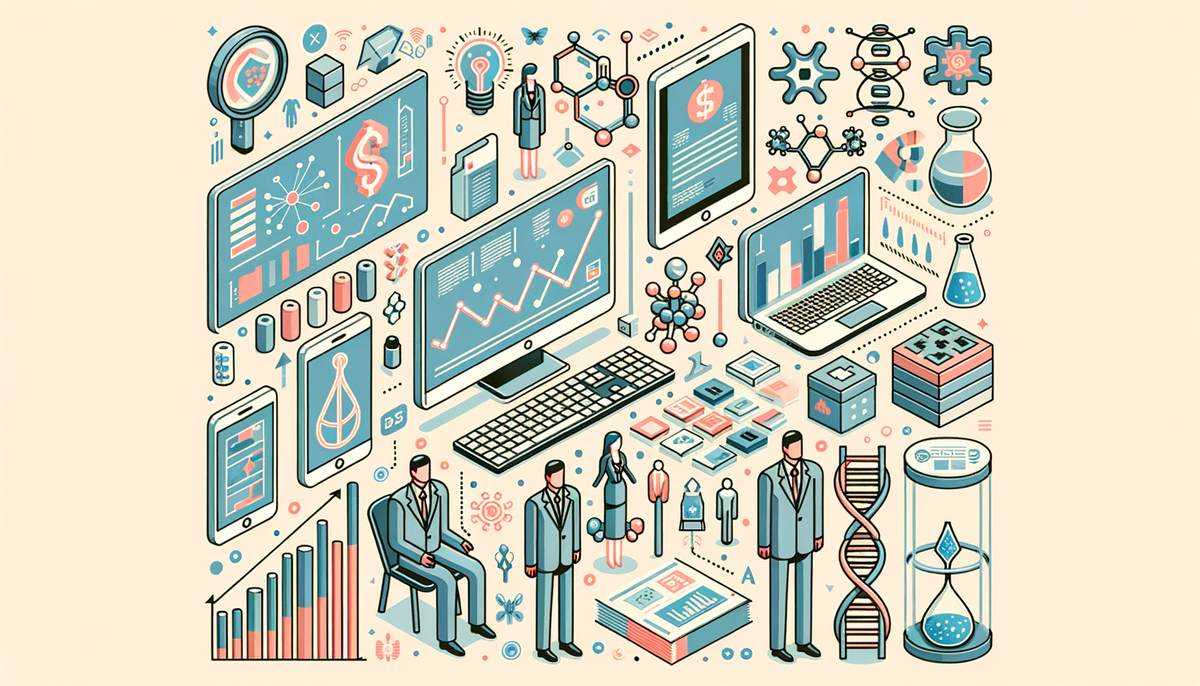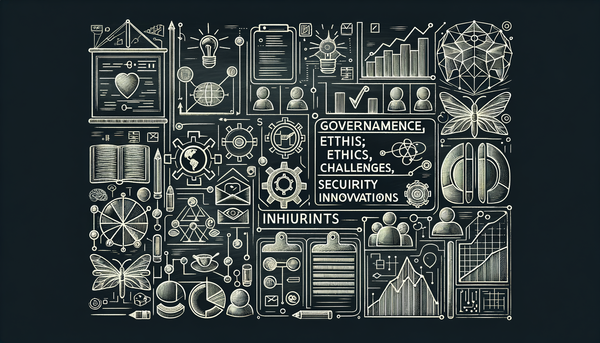AI Developments Update: Transformations Across Industries

Did you know that rigorous experiments by the DoD now enable easier transitions between AI vendors, sparking a multi-industry revolution that touches everything from corporate boardrooms to gene research labs? A close look reveals CEOs harnessing AI tools to streamline business practices, stunning chip innovations promising to redefine computing, and even groundbreaking browser enhancements that transform our daily digital engagements.
Dynamic Shifts in AI Adoption Across Industries
The defense sector is leading the charge with its latest tests on AI models that are designed to facilitate nimble transitions between vendors, as exemplified by trials that might soon allow homeowners of critical systems to switch seamlessly from entrenched providers like Palantir. This move not only signals a robust governmental embrace of AI flexibility but also sets the stage for a broader industry trend where agility and adaptability become prized assets.
Meanwhile, high-level executives across diverse sectors are increasingly integrating AI into their day-to-day operations. In an insightful discussion featured by a prominent business media outlet, seven CEOs and a chief commercial officer shared first-hand how AI is transforming the way decisions are made and operations are run. Whether it is through advanced data analytics or intelligent automation, these leaders are actively shaping a future where AI is an indispensable tool rather than a mere adjunct technology.
Not to be outdone, competitive marketplace dynamics have started to change, with even some of the long-standing tech giants feeling the pinch. Rivals of Microsoft are now leaning heavily on AI strategies to woo customers away from established brands. Such competitive maneuvers are reshaping customer engagement and are of particular interest to those who follow market trends on platforms like AI Podcast by AI.Biz.
Advancements in AI Hardware and Chip Innovations
There has been a significant buzz around a new chapter in AI hardware. A $16.5 billion deal between Tesla and Samsung to manufacture AI chips is stirring industries, promising to deliver unprecedented processing capabilities to next-generation vehicles and smart devices. It’s a tale of strategic alliances that underscore the idea that novel hardware is as crucial as sophisticated algorithms. The commitment, in this case, is not just in building faster chips, but in creating smarter platforms where AI can flourish.
Adding more intrigue to the conversation is Nvidia’s latest consumer chip—codenamed the N1X—which recently made headlines in a Geekbench benchmark. Despite boasting an impressive 6,144 CUDA cores, the sample’s performance indicators remind us that raw numbers, while exciting, are only one piece of the puzzle. The chip, which features an integrated GPU with 48 Streaming Multiprocessors distributed across twenty cores, exudes potential for casual gaming and everyday computing. However, challenges remain in clock speed, power efficiency, and memory bandwidth that distinguish integrated solutions from fully dedicated GPUs.
Reflecting on this, I often recall the famous words of Andrew Ng who once remarked,
“Artificial intelligence is the new electricity.”
This metaphor underlines not only the transformative potential of AI but also emphasizes the need for robust, innovative hardware solutions that can power these intelligent systems. The evolution seen with Nvidia’s chip is a testament to the immense efforts being invested in balancing performance with efficiency.
AI in Scientific Research and Educational Arenas
Beyond the realms of business and defense, AI continues to make a significant impact in scientific research. A standout example is an AI agent designed to enhance gene set analysis. By leveraging expert-curated databases, this tool is improving the accuracy of genetic research—a development that could accelerate breakthroughs in personalized medicine and genomics. Imagine a scenario where scientists, by harnessing such AI-driven methodologies, can quickly pinpoint gene interactions that underpin various diseases. The possibilities are vast and, at the same time, deeply promising.
The influence of AI even extends into the domain of education and youth innovation. Remarkably, high school students have recently outperformed some of the world's most advanced AI models in certain tasks. This unexpected turn not only defies assumptions about age and technological prowess but also hints at future shifts in AI training and learning paradigms. Their successes reiterate the need for continuous adaptation and rethinking of AI benchmarks and evaluative standards.
Such achievements remind me of the timeless lesson that innovation often comes from unexpected sources, and that competition—whether between AI and human intellect or among various AI solutions—can catalyze remarkable progress. Their successes and challenges may look like lessons from a classroom, yet they bear the weight of future breakthroughs.
Business Dynamics and Evolving Market Strategies
AI’s influence on business strategy is becoming increasingly prominent. A striking industry event was the sale of the Dallas-based AI company Cognigy for nearly $1 billion. This transaction not only reflects a strong investor appetite for AI innovations but also indicates a maturing market where valuation and performance are starting to align more clearly with real-world applications. Such deals resonate deeply with market enthusiasts and signal that strategic investments in AI are likely to rise in the coming years.
In parallel, the role of AI in shaping modern marketing strategies is also coming under scrutiny. As organizations deploy AI to revamp influencer marketing campaigns, questions about authenticity, efficiency, and reach are being raised. Here, it is not just about automation. Instead, it’s about leveraging insights and predictive capabilities to craft messages that resonate in today's fast-paced digital ecosystem. These developments are prompting marketers to balance their creative inclinations with data-backed strategies, ensuring that influencer campaigns aren’t just trendy, but also effective.
Moreover, integrating AI into everyday business decisions has become a common practice among top-tier executives. Several CEOs have shared insights on how AI not only streamlines workflows but also offers a competitive edge by analyzing vast amounts of data in real time. This shift towards data-driven decision-making highlights an evolution from intuition-based choices to informed strategies—a transformation likely to continue as more industries adopt advanced AI systems.
AI Revolutionizing User Experience on Digital Platforms
One of the most exhilarating developments in the realm of AI has been its integration into consumer software. Microsoft, for instance, is revolutionizing the Edge web browser with a feature popularly known as “Copilot Mode.” This experimental upgrade transforms browsing into an interactive experience, where an AI companion works across multiple tabs, offering contextual suggestions and managing routine tasks. The result is a streamlined and personalized online journey that caters to both productivity and comfort.
Copilot Mode exemplifies how AI is not just about automating routine tasks but also about enhancing user experience by making digital interactions more intelligent. Users can simply issue natural language commands—be it for booking reservations or retrieving information—and watch the AI process these requests with a swift responsiveness that feels almost intuitive. Although Microsoft’s current iteration of this feature is free, the company hints at an eventual subscription model that may redefine access to advanced AI tools on everyday devices.
This trend of integrating AI into consumer-focused platforms is reminiscent of the broader transformation we are witnessing across industries. Features like Copilot Mode are paving the way for a future where digital assistants might not only manage our web browsing experience but also serve as integrated hubs for personal productivity. If one considers the broader context, it seems like we are on the cusp of an era where AI is embedded so deeply into our daily activities that it becomes nearly invisible—seamlessly adaptive to our needs.
Insights from the AI Ecosystem: Trends and Future Directions
When examining the broader ecosystem, a recurring theme emerges—the intertwining of advanced hardware, cutting-edge software, and innovative business strategies is driving a holistic evolution in AI. From government applications where AI models are tested for defensive flexibility to groundbreaking chip deals and research applications in genomics, the field is diversifying faster than ever.
It is fascinating to observe how different sectors are converging around a single technological revolution. Recent updates available on AI.Biz, such as the in-depth discussions on infrastructure shifts and innovative podcasts covering the latest developments in artificial intelligence, provide evidence of a vibrant community eager to explore and adapt to these changes. For instance, you might find it interesting to delve into discussions on infrastructure and innovations at AI Podcast by AI.Biz or check out more narrative updates from our latest AI news podcast.
Furthermore, looking at the strategic moves—from corporate boardrooms to research labs—it is clear that the rapid evolution of AI is affecting everyone. As one expert insightfully put it,
“As a technologist, I see how AI and the fourth industrial revolution will impact every aspect of people's lives.”
Such observations not only validate the transformative impact of AI but also serve as a reminder to continuously adapt and innovate.
The interplay between innovative technology development and its practical application remains at the core of this transformation. Businesses are learning to harness data and AI to navigate an ever-evolving competitive landscape, while research institutions are employing AI to unlock new scientific insights that promise to revolutionize fields such as medicine, genomics, and more.
Looking Ahead: Balancing Innovation with Real-World Challenges
As we stand at the intersection of these varied developments, one thing is clear—AI is no longer a futuristic concept but a present reality that is redefining industries. Whether it is bridging the gap between hardware and software, refining research methodologies, or transforming digital user experiences, the journey of AI is one of both exhilarating promise and pragmatic challenges.
Industry players must balance the thrill of groundbreaking innovations, such as Nvidia's N1X chip or Microsoft's Copilot Mode, with the realities of market adoption and performance constraints. This balanced approach is crucial to ensuring that as AI systems become more integrated into our everyday lives, they remain both accessible and effective.
With transformative deals like the Tesla-Samsung AI chip agreement and major corporate investments around AI startups, the momentum appears unstoppable. The AI ecosystem is continuously proving that progress is not linear—it is a complex tapestry of breakthroughs, recalibrations, and unexpected victories. And as we adapt to these ongoing shifts, it is important to remember that behind every technical evolution lies a story of creative problem-solving and resilient human spirit.
I invite you to keep exploring, stay curious, and perhaps even test some of these emerging technologies for yourself. The future of AI is unfolding right before our eyes, and with every new development, we edge ever closer to a world where technology and human ingenuity coalesce harmoniously.




